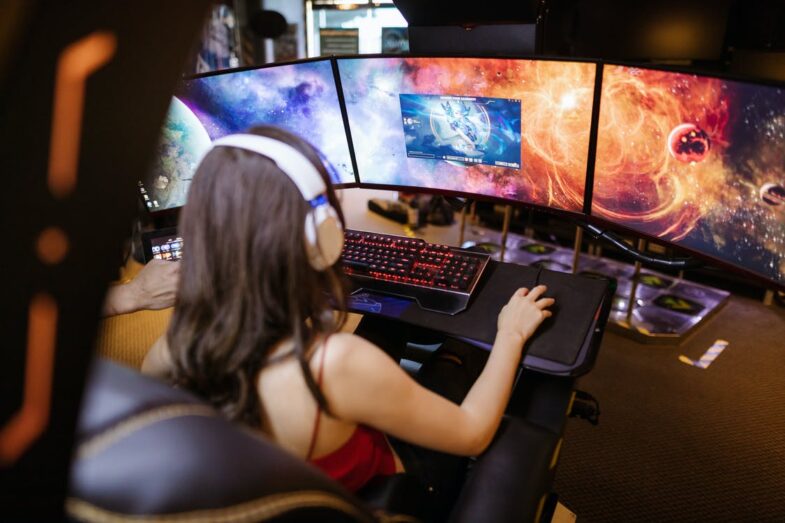What is gamification? What does it mean for education? What are the advantages and disadvantages of gamification? And why is it important in the classroom? These questions and more will be answered in this article. But before we get into specifics, it’s helpful to understand some examples. First, let’s understand the nature of gaming. Many adults are interested in playing video games, and this is especially true for students. Whether you are a child or an adult, everyone can enjoy playing engaging games and learning something new.
What is gamification?

Source: pexels.com
It’s a way to turn the learning process into a game. You can use this same strategy to motivate your students to complete educational projects. You can learn more about gamification in education by reading this article.
Games encourage students to learn new material by engaging them in a story. In video games, players are rewarded for winning with trophies, points, and leader boards. The competition method is often implemented to improve learning.
In education, gamification can be used as a learning tool in this way too. It adds points that are not influencing the grade, and it makes it easier for students to live. It introduces an element of play into a non-game context, which encourages students to study harder and creates a more positive mental attitude toward learning. When applied to learning in school, gamification is a great way to tie loose lessons into a coherent experience. If done correctly, it improves motivation and turns the learning process from a chore to fun.
So, gamification in education has multiple pros. One of the most popular ones is the ability to make students more involved and make teachers closer. By allowing students to compete against each other, educators hope to translate the benefits of games into a more informal learning environment. Gamification also helps students to learn new concepts and apply them outside of the classroom. Educators hope that games translate into learning beyond the classroom.
How does gamification help education?

Source: pexels.com
Teachers and educators need to find new methods to ignite student interest in learning. Gamification can help them do just that by promoting student engagement and motivation. This method is a great way to reinforce academic and self-regulation skills while rewarding students for their efforts. Gamification also allows teachers to pair subjects with fun activities. Students will often work harder to achieve their goals when they are rewarded for their efforts, making it a great way to motivate students to succeed. As a part of the education system, a team of Classtaker.net took part in testing the gamification for learning and it was a great experience.
Students benefit from games that encourage them to think creatively. These games encourage them to think outside of the box by giving them new tasks. They can be completed individually or in groups, so students can compete amongst themselves. Gamification helps to promote learning by promoting the storage of new information in long-term memory.
Gamification has also been linked to the production of dopamine, which plays a role in memory and learning. This chemical boosts the brain’s concentration levels and increases memory.
Gamification isn’t for every class. Gamified classrooms need to be designed for a certain grade level. For example, primary grade students typically have smaller class sizes and stay with the same teacher all day. In this way, students are exposed to a gamified environment on a consistent basis, allowing them to recover from low grades and move up through the grades.
However, there are many benefits of gamification in education.
Video games are the perfect example of this. Gamification can help students engage in learning by creating scenarios that encourage them to act autonomously, demonstrate competence, and learn in context. The same principle can apply to educational video games. These games can also be used to assess students’ learning progress. The ability to track student progress using virtual badges and trophies is an added bonus. There are many more ways to incorporate gamification into education.
Additionally to the above, virtual reality gaming is one of the most exciting possibilities.
What are the disadvantages of gamification?

Source: pexels.com
A key concern with gamification in the education setting is the potential to undermine students’ attention spans. Students who are invested in winning games are likely to learn less than students who are less focused on learning. However, gamification can be an effective supplement to other learning strategies. It can help students get more out of their education and enhance their self-esteem. Here are some potential disadvantages to consider before implementing gamification in the educational setting.
Those who are skeptical of gamification in education may worry that it will distract from the learning process. However, gamification is widely used in other fields, including entertainment and learning. Many video games are designed to encourage students to take actions. Gamification can make a classroom more engaging by allowing students to insert themselves into different scenarios and respond to their needs. Moreover, games can promote creative thinking and perseverance, which are highly valued by employers.
Gamification is also not safe for educators. Depending on the type of game, there may be risks involved. Besides increasing distractions, gamification may not be suitable for all kinds of learning environments. For example, gamification may be harmful to students with learning disabilities. While this technology is great for the general public, the educational system must be aware of these risks. As with any other technology, gamification in education has many disadvantages.
One of the biggest drawbacks of gamification in the educational setting is the lack of flexibility for teachers. Teachers must still ensure that students are demonstrating proficiency on state standards, so gamification in the educational environment may not be feasible for everyone. Additionally, teachers may not have enough freedom to incorporate peripheral content.
The limited options make gamification in the education setting minimal. As a result, it may also lead to decreased student engagement.
Gamification examples

Source: pexels.com
In traditional classrooms, personalization can be a challenge. High achievers might not feel challenged enough, while low-grade students could get discouraged because of low motivation. A good gamification example for a classroom is a math curriculum called Knowre, which allows instructors to personalize course material and give customized instructions to students. Students are challenged to break down concepts in a step-by-step process, receive consistent feedback, and improve on areas of weakness.
Another example of a gamified quiz is the Open University’s Facial Recognition Game. Students complete the quiz to contribute valuable data to facial recognition research. Students are rewarded for participating, and the game has an element of competition. They may even want to share the quiz with their friends! Gamification examples for education will help teachers create the perfect environment for this learning tool. This innovative approach to teaching is highly effective, but it does require a lot of resources.
Many students struggle with learning disabilities and other disabilities, and often come to school each day after a hard day at home. Games with an element of agency are ideal for motivating students. Gamification allows students to take risks in the classroom while not destroying their self-esteem or confidence. Hence, teachers and other educators should try these out in their classrooms. So, what are the benefits of using gamification in the classroom?
For educators, gamification in education can be a great way to increase learning motivation. Gamification encourages learners to work hard at a task they enjoy, thereby fostering intrinsic motivation. By creating rewarding mechanisms, educators can encourage students to achieve their goals. It also promotes a culture of continuous learning and on-the-job development. Gamification for education does not have to be complicated. Adding gamification elements to online courses can help make the content stick to students’ minds.
Gamification learning techniques

Source: pexels.com
A common goal of gamification is to increase motivation. However, motivation is a multifaceted concept – different people have different motivations and are shaped by their activities. For that reason, a successful game in one educational context does not guarantee success in another. Gamification has the potential to transform traditional education by fostering motivation in the informal world. This article will discuss the benefits and limitations of gamification for education.
The use of gamification techniques can be incorporated into any lesson structure. Incorporating this technology into the learning environment will affect the role of the student, teacher, and environment. For example, students may adopt a name or avatar that represents them in the game and form teams or guilds. The goal of these guilds or teams may be to improve each other’s guild. Students may also be encouraged to help other students in their guilds.
While gamification techniques are not without their challenges, there are some promising applications. While gamification is not always a substitute for traditional lecture methods, it can be a valuable tool during post-COVID times. In the short run, gamification may prove to be a viable option for students and educators alike. But it is best to conduct research if it can be proven in a classroom environment. This way, gamification will not only be able to increase engagement, but will also help to reduce student stress levels.
